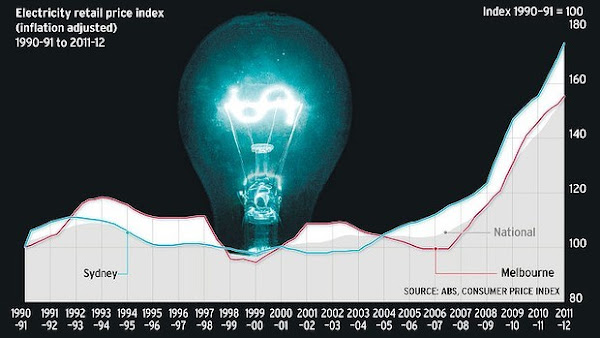Efficient appliances are recognisable by energy-star ratings. There is no way to recognise a grid-friendly appliance.

|
| Grid-Friendly Appliances |
"Aren't more efficient appliances grid-friendly?"
Well, no. At least not necessarily. A more efficient air-conditioner may only need 4 kilowatt-hours to do the same job that an earlier version required 5 kilowatt-hours to do. A 20 percent improvement. Now if the earlier version used 5 kilowatt-hours over a 24-hour period and the new model insists on receiving 4 kilowatt-hours all in one 30-minute gulp right in the middle of a peak demand period, then the more efficient air-conditioner is most definitely less grid-friendly than the previous model.
"How exactly will grid-friendly appliances help?"
Grid-friendly appliances first and foremost help to reduce the cost of supplying electricity by providing a flexible load. When extra generating and transmission capacity is unused during off-peak periods, grid-friendly appliances will provide a market instead of allowing that capacity to go unused.
When the breeze suddenly drops and a wind-turbine farm output falls, the grid-friendly appliances will drop out and avoid the cost of backup generators to fill in.
"What would make a good grid-friendly appliance?"
An electric vehicle being recharged over an extended period from a smart power point is a good candidate for a grid-friendly appliance. It stays in its garage or parking spot connected to the electricity grid. It won't care if charging is deactivated from time to time, or that charging is enabled by an external signal when capacity becomes available.
Another candidate would be an air-conditioning system that creates and stores a large quantity of ice that it makes whenever it is convenient for the grid to supply it with electricity. The air-conditioning of buildings and homes of the owners proceeds without interruption because only a very small amount of energy is needed to deliver cooling from the ice-store. A hot-water storage system is a similar candidate for a grid-friendly appliance. A heat pump is a more efficient hot-water system than a resistive heater, but both could be equally grid-friendly.
"Do we need changes to market rules and standards?"
There is some experience with market rules and standards that help identify where changes can assist in promoting grid-friendly appliances to achieve the objective of reducing the cost of energy.
The energy-star rating standard that identifies energy-efficient appliances is a model that could be adapted for a new "grid-friendly rating" of appliances.
Queensland and Western Australian electricity retailers have experimented with offering electricity discounts to customers who install demand-responsive air-conditioners. This is a model that can be used to encourage the take-up of grid-friendly appliances
The next examples point to a minor failing with an aspect of the electricity market: The disappearing price signal. A major electricity grid owner recognised a cause of inefficiency in the use of its infrastructure, and set a high price to send a clear price signal to encourage large energy consumers to remedy it. However, these energy consumers had supply contracts with retailers who just passed on the "price signal" from the grid owner but did not give the customers the information they needed to assess if they were able to do anything about responding to it. One customer looking for a solution to a completely different problem stumbled by serendipity upon this hidden price signal. The result: an immediate$10,000 investment by the customer in a device to solve the grid owner's legitimate concerns over inefficient grid use. The ensuing $5,000 reduction in the customer's annual electricity bill, was the intended response to the grid owner's "price signal". This example is written up in the post The other smart meter hazard.
A similar situation is developing with "grid-unfriendly" appliances. Major electricity grid owners are proposing a "price signal" with dynamic charges to increase the cost of electricity during times of grid stress so consumers will be "persuaded" to turn off appliances. After one trial a grid owner considered that a dynamic charge of about 70 cents per kilowatt-hour is needed to get consumers to turn-off "grid-unfriendly" appliances. This trial is written up in the post Get Ready for Electricity at 70 cents per kWh.
This proposal cannot begin until after the roll-out of smart meters in an enormously costly and time-consuming project. This approach was adopted by the former Victorian State Government in Australia. This is not exactly the same as the "disappearing price signal" example above. Instead it leaves consumers receiving the price signal, eventually, but being at a loss to find a satisfactory way to respond. It is also very expensive to install smart meters universally. This undermines the purpose which is to reduce the cost of delivering energy.
An alternate strategy with lower costs and inconvenience is to offer smart meters to consumers at the time they choose to install grid-friendly appliances. This allows Time Of Use (TOU) charges to reward these consumers with discounted energy for helping to reduce grid infrastructure costs: More carrot, less stick.






